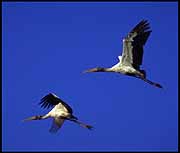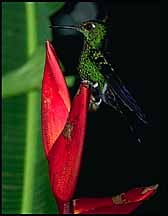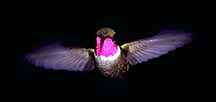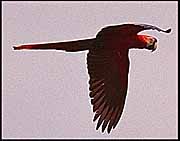Birds
by
Christopher Baker
Home : Travel : Costa Rica : CR Handbook : One Article
In William Henry Hudson's Green Mansions, his great romantic
novel of the American tropics, the young hero Abel is lured into the jungle by
the mysterious call of an unseen bird. So stirred is he by the siren song that
he follows the haunting sound deeper and deeper into the forest until he
eventually discovers the source: a lovely, half-wild girl called Rima, who has
learned to mimic the sounds of the birds. The birdlife of Costa Rica is so rich
and so varied--and often so elusive--that at times it seems as if Rima herself
is calling.
With approximately 850 recorded bird species, the country boasts
one-tenth of the world's total. More than 630 are resident species; the
remainder are occasionals who fly in for the winter. Birds that have all but
disappeared in other areas still find tenuous safety in protected lands in
Costa Rica, though many species face extinction due to deforestation. The
nation offers hope for such rare jewels of the bird world as the quetzal and
the scarlet macaw, both endangered species yet commonly seen in protected
reserves.
BIRDWATCHING
 Fortunately, Costa Rica's birds are not shy. Seeing them is relatively
easy. Depending on season, location, and luck, you can expect to see many
dozens of species on any one day. Many tour companies offer guided bird-study
tours (see "Special-interest Travel and Recreation," in the "Out and About"
chapter), and the country is well set up with mountain and jungle lodges which
specialize in birdwatching programs (see "Mountain and Jungle Lodges," pp.
96-97).
Fortunately, Costa Rica's birds are not shy. Seeing them is relatively
easy. Depending on season, location, and luck, you can expect to see many
dozens of species on any one day. Many tour companies offer guided bird-study
tours (see "Special-interest Travel and Recreation," in the "Out and About"
chapter), and the country is well set up with mountain and jungle lodges which
specialize in birdwatching programs (see "Mountain and Jungle Lodges," pp.
96-97).
The deep heart of the jungle is not the best place to look for
birds: you cannot see well amid the complex, disorganized patterns cast by
shadow and light. For best results, find a large clearing on the fringe of the
forest, or a watercourse where birds are sure to be found in abundance.
There are four major "avifaunal zones," which roughly correspond to
the major geographic subdivisions of the country: the northern Pacific
lowlands, the southern Pacific lowlands, the Caribbean lowlands, and the
interior highlands. Guanacaste's dry habitats (northern Pacific lowlands) share
relatively few species with other parts of the country. This is a superlative
place, however, for waterfowl: the estuaries, swamps, and lagoons which make up
the Tempisque Basin support the richest freshwater avifauna in all Central
America, and Palo Verde National Park, at the mouth of the Tempisque, is a
birdwatcher's mecca.
The southern Pacific lowland region is home to many South American
neotropical species, such as jacamars, antbirds, and, of course, parrots. Here,
within the dense forests, the air is cool and dank and underwater green and
alive with the sounds of birds. The bright-billed toucans--"flying
bananas"--are a particular delight to watch as they pick fruit off one at a
time with their long beaks, throw them in the air and catch them at the back of
their throats. Costa Rica's six toucan species are among the most flamboyant of
all Central American birds. That loud froglike croak is the Swainson's toucan;
that noisy jumble of cries and piercing creaks could well be a congregation of
gregarious chestnut-mandibled toucans.
In fact, many birds are easily heard but not seen. The
three-wattled bellbird, which inhabits the cloud forests, is rarely spotted in
the mist-shrouded treetops, though the male's eerie call, described by one
writer as a "ventriloqual `bonk!'" (it is more like a hammer clanging on an
anvil), haunts the forest as long as the sun is up. And the lunatic laughter
that goes on compulsively at dusk in lowland jungles is the laughing falcon.
Fortunately other species, like the tanagers, brighten the jungle, and you are
likely to spot their bright plumage as you hike along trails. The tanagers'
short stubby wings enable them to swerve and dodge at high speed through the
undergrowth as they chase after insects.
The sheer size of Costa Rica's bird population has prompted some
intriguing food-gathering methods. The jacamar snaps up insects on the wing
with an audible click of its beak. One species of epicurean kite has a bill
like an escargot fork which it uses to pick snails from their shells. The
attila, like its namesake a ruthless killer, devours its frog victims whole
after bashing them against a tree.
Other birds you might expect to see include the boobies, the rare
harpy eagle (the largest of all eagles, renowned for twisting and diving
through the treetops in pursuit of monkeys), pelicans, parakeets, oropendolas,
woodpeckers, and a host of birds you may not recognize but whose names you will
never forget: scarlet-thighed dacnis, violaceous trogons, tody motmots,
laneolated monlets, lineated foliage-gleaners, and black-capped pygmy
tyrants.
HUMMINGBIRDS

Of all the exotically named bird species in Costa Rica, the hummingbirds
beat all contenders. Their names are poetry: the green-crowned brilliant,
purple-throated mountaingem, Buffon's plummeteer, and the bold and strikingly
beautiful fiery-throated hummingbird. There are more than 300 species of New
World hummingbirds constituting the family Trochilidae (Costa Rica has 51), and
all are stunningly pretty. The fiery-throated hummingbird, for example, is a
glossy green, shimmering iridescent at close range, with dark blue tail,
violet-blue chest, glittering coppery orange throat, and a brilliant blue crown
set off by velvety black on the sides and back of the head. Some males take
their exotic plumage one step further and are bedecked with long streamer tails
and iridescent moustaches, beards, and visors.
 These tiny high-speed machines are named because of the hum made by
the beat of their wings. At up to 100 beats per second, the hummingbirds' wings
move so rapidly that the naked eye cannot detect them. They are often seen
hovering at flowers, from which they extract nectar and often insects with
their long, hollow, and extensile tongues forked at the tip. Alone among birds,
they can generate power on both the forward and backward wing strokes, a
distinction that allows them to even fly backwards!
These tiny high-speed machines are named because of the hum made by
the beat of their wings. At up to 100 beats per second, the hummingbirds' wings
move so rapidly that the naked eye cannot detect them. They are often seen
hovering at flowers, from which they extract nectar and often insects with
their long, hollow, and extensile tongues forked at the tip. Alone among birds,
they can generate power on both the forward and backward wing strokes, a
distinction that allows them to even fly backwards!
Understandably, the energy required to function at such an intense
pitch is prodigious. The hummingbird has the highest metabolic rate per unit of
body weight in the avian world (its pulse rate can exceed 1,200 beats a minute)
and requires proportionately large amounts of food. One biologist discovered
that the white-eared hummingbird consumes up to 850% of its own weight in food
and water each day. At night, they go into "hibernation," lowering their body
temperatures and metabolism to conserve energy.
Typically loners, hummingbirds bond with the opposite sex only for
the few seconds it takes to mate. Many, such as the fiery-throated hummingbird,
are fiercely territorial. With luck you might witness a spectacular aerial
battle between males defending their territories. In breeding season, the males
"possess" territories rich in flowers attractive to females: the latter gains
an ample food source in exchange for offering the male sole paternity rights.
Nests are often no larger than a thimble, loosely woven with cobwebs and flecks
of bark and lined with silky plant down. Inside, the female will lay two eggs
no larger than coffee beans.
MACAWS

What magnificent creatures these birds are. No protective coloration. No
creeping about trying to blend in with the countryside. Macaws--the largest of
the neotropical parrots--are dazzlingly colored in jackets of bright yellow and
blue, green, or scarlet. Their harsh, raucous voices are filled with authority.
"Even moving from branch to branch in the treetops," says one writer, "they
seem arrogant and proud as emperors."
Although macaw is the common name for any of 15 species of these
large, long-tailed birds found throughout Central and South America, only two
species inhabit Costa Rica: the scarlet macaw (lapa roja) and the great
green or Buffon's macaw (lapa verde). Though the scarlet ranges from
Mexico to central South America and was once abundant on both coasts of Costa
Rica, today it is found only in a few parks on the Pacific shore, and rarely on
the Caribbean side, which is the home of the Buffon's macaw. Both bird
populations are losing their homes to deforestation and poaching. The scarlet
macaw population has declined so dramatically that it is now in danger of
disappearing completely: there are only three wild populations in Central
America that have a long-term chance of survival--at Carara Biological Reserve
and Corcovado in Costa Rica, and Coiba Island in Panama--although macaws can
also be seen with regularity at Palo Verde National Park, Santa Rosa National
Park, and other forested parts of the Gulf of Nicoya and Osa Peninsula. There
are an estimated 200 scarlets at Carara and 1,600 at Corcovado, where as many
as 40 may be seen at one time.
 As they fly overhead, calling loudly, their long, trailing tail
feathers and short wings make it impossible to confuse them with other birds.
They are gregarious and rarely seen alone. They are almost always paired male
and female--they're monogamous for life--often sitting side by side, grooming
and preening each other, and conversing in rasping loving tones, or flying two
by two. However, it is impossible to tell male from female. The scarlet's
bright red-orange plumage with touches of blue and yellow does not vary between
the sexes or with aging.
As they fly overhead, calling loudly, their long, trailing tail
feathers and short wings make it impossible to confuse them with other birds.
They are gregarious and rarely seen alone. They are almost always paired male
and female--they're monogamous for life--often sitting side by side, grooming
and preening each other, and conversing in rasping loving tones, or flying two
by two. However, it is impossible to tell male from female. The scarlet's
bright red-orange plumage with touches of blue and yellow does not vary between
the sexes or with aging.
Macaws usually nest in softwood trees, such as jallinazos, where
termites have hollowed out holes. April through July, you might see small
groups of macaws clambering about the upper trunks of dead trees at Corcovado,
squabbling over holes and crevices. In Carara, nesting season begins in
September.
Many bird books mistakenly describe macaws as feeding on
fruits--they get their names because they supposedly feed on the fruits of the
macaw palms. In fact, they rarely eat fruits, but prefer seeds and nuts, which
they extract with a hooked nutcracker of such strength that it can split that
most intractable of nuts, the Brazil nut.
Macaw Protection
Several conservation groups are working to stabilize and reestablish the
scarlet macaw population. Deep in the forest of the Carara Biological Reserve,
Sergio Volio (a former national park superintendent and owner of Geotur)
oversees a project to build artificial nests high up in jallinazo trees beyond
the reach of poachers. Although macaws are the biggest attraction at Carara,
they are threatened with extinction by poachers who take the chicks to sell on
the black market in the U.S., despite a ban that prohibits importing the birds.
Most die, however, before they reach the United States. Volio estimates up to
95% of natural nests at the reserve are poached. Volio's is the first project
that will protect the birds' breeding grounds in their natural habitat. He is
currently forming a foundation to accept donations to help build the
birdhouses, which cost about $100. Contact: Geotur, P.O. Box 469Y
Griegia, San José 1011; tel. 234-1867, fax 253-6338.
Tsuli/Tsuli, an independent, self-supporting chapter of the
Audubon Society, has an Adopte un Ave (Adopt-a-Bird) program. Tsuli/Tsuli means
"Many Parrots" in the language of the Cabécar Indians. The group has an
environmental education program to teach local Costa Ricans to understand and
appreciate their flora and fauna, with a special emphasis on protecting birds,
especially parrots, which are symbols of tropical wilderness. Contact:
Tsuli/Tsuli, Audubon de Costa Rica, Apdo. 4910, San José 1000; tel.
249-1179, fax 249-1179; or P.O. Box 025216-700, Miami, FL 33102.
Tsuli Tsuli supports Richard and Marge Frisius, two experienced
aviculturists who have a macaw-breeding program on the grounds of their home in
Río Segundo de Alajuela. The Frisiuses have successfully raised many
baby macaws using special techniques and cages. By teaching the domestically
raised macaws how to find native food and then releasing them into carefully
selected wilds of Costa Rica, the goal is to reestablish flocks of these
magnificent birds in parts of the nation where there is still appropriate
habitat for viable populations to establish themselves. The Frisiuses need at
least 15 breeding pairs of macaws to establish a large gene pool. They also
need to construct a large cage in which the birds can fly and forage freely
(approximate cost $75,000). The couple have formed their own nonprofit
organization, Amigos de las Aves, to raise money (send donations to:
Apdo. 32, Río Segundo 4001).
QUETZALS
The quetzal, or resplendent trogon, is a rare jewel of the bird world.
Many birdwatchers travel to Costa Rica simply to catch site of this magnificent
bird. What this pigeon-sized bird lacks in physical stature it makes up for in
audacious plumage: vivid, shimmering green which ignites in the sunshine,
flashing emerald to golden and back to iridescent green. In common with other
bird species, the male outshines the female. He sports a fuzzy pink punk
hairdo, a scintillating crimson belly, and two brilliant green tail plumes up
to 24 inches long, edged in snowy white and sinuous as feather boas.
Its beauty was so fabled and the bird so elusive and shy that early
European naturalists believed the quetzal was a fabrication of Central American
natives. In 1861, an English naturalist, Osbert Salvin, wrote that he was
"determined, rain or no rain, to be off to the mountain forests in search of
quetzals, to see and shoot which has been a daydream for me ever since I set
foot in Central America." Salvin, the first European to record observing a
quetzal, pronounced it "unequaled for splendour among the birds of the New
World," and promptly shot it. During the course of the next three decades,
thousands of quetzal plumes crossed the Atlantic to fill the specimen cabinets
of European collectors and adorn the fashionable milliners' shops of Paris,
Amsterdam, and London. Salvin redeemed himself by authoring the awesome
40-volume tome Biologia Centrali Americana, which provided virtually a
complete catalog of neotropical species.
Quetzal Culture
The quetzal has long been revered in Guatemala, where the bird graces the
national shield, flag, postage stamps, and currency (which happens to be called
the quetzal). It is pleasing to know that the former center of the Mayan
empire still honors the magnificent bird. Early Mayans and Aztecs worshiped a
god called Quetzalcoatl, the Plumed Serpent, and depicted him with a headdress
of quetzal feathers. The bird's name is derived from quetzalli, an Aztec
word meaning "precious" or "beautiful."
Mayans considered the male's iridescent green tail feathers worth
more than gold, and killing the sacred bird was a capital crime. Quetzal plumes
and jade, which were traded throughout Mesoamerica, were the Mayans' most
precious objects. It was the color that was significant: "Green--the color of
water, the lifegiving fluid. Green, the color of the maize crop, had special
significance to the people of Mesoamerica," says Adrian Digby in his monograph
Mayan Jades, "and both jade and the feathers of the quetzal were
green."
During the colonial period, the indigenous people of Central
America came to see the quetzal as a symbol of independence and freedom.
Popular folklore relates how the quetzal got its dazzling blood-red breast: in
1524, when the Spanish conquistador Pedro de Alvarado defeated the Mayan
chieftain Tecun Uman, a gilt-and-green quetzal alighted on the Indian's chest
at the moment he fell mortally wounded; when the bird took off again, his
breast was stained with the brilliant crimson blood of the Mayan.
Archaeologists believe that the wearing of quetzal plumes was
proscribed, under pain of death, for use by Mayan priests and nobility: it
became a symbol of authority vested in a theocratic elite, much as only Roman
nobility were allowed to wear purple silks.
Quetzal Watching
Although Costa Ricans don't worship the quetzal with the same fervor as
pre-Columbian Guatemalans, the bird is most easily seen in Costa Rica, where it
is protected in four national parks--Braulio Carrillo, Poás,
Chirripó, La Amistad--and the Monteverde and Los Angeles cloud forest
reserves. Everywhere throughout its 1,000-mile range (from southern Mexico to
western Panama) it is endangered due to loss of its cloud-forest habitat. This
is particularly true of the lower forests around 1,500 to 2,000 meters to which
families of quetzals descend during breeding season (March-June), and where
they seek dead and decaying trees in which to hollow out their nests. This is
the best time to see narcissistic males showing off their tail plumes in
undulating flight, or launching spiraling skyward flights which presage a
plummeting dive with their tail feathers rippling behind, all part of the
courtship ritual.
At other times, the wary birds aren't easily spotted. Their plumage
offers excellent camouflage under the rainy forest canopy. They also sit
motionless for long periods, with their vibrant red chests turned away from any
suspected danger. If a quetzal knows you're close by and feels threatened, you
may hear a harsh weec-weec warning call and see the male's flicking tail
feathers betray his presence. The quetzal's territory spans a radius of
approximately 300 meters, which the male proclaims each dawn through midmorning
and again at dusk with a telltale melodious whistle--a hollow, high-pitched
call of two notes, one ascending steeply, the other descending--repeated every
eight to 10 minutes.
Nest holes (often hollowed out by woodpeckers) are generally about
30 feet from the ground. Within, the female generally lays two light-blue eggs,
which take about 18 days to hatch. Both sexes share parental duties. By day,
the male incubates the eggs while his two-foot-long tail feathers hang out of
the nest. At night, the female takes over.
Although the quetzal eats insects, small frogs, and lizards, it
enjoys a penchant for the fruit of the broad-leafed aguacatillo (a kind
of miniature avocado in the laurel family), which depends on the bird to
distribute seeds. The movement of quetzals follows the seasonal fruiting of
different laurel species. Time your birdwatching visit, if possible, to
coincide with the quetzals' rather meticulous feeding hours, which you can
almost set your watch by. They're fascinating to watch feeding: an upward swoop
for fruit is the bird's aerial signature.
FRIGATE BIRDS
Black frigate birds, with their long scimitar wings and forked tails,
hang like sinister kites in the wind all along the Costa Rican coast. They hold
a single position in the sky, as if suspended from invisible strings, and from
this airborne perch harry gulls and terns until the latter release their catch
(birders have a name for such thievery: kleptoparasitism).
Despite the sinister look imparted by its long hooked beak, the
frigate bird is quite beautiful. The adult male is all black with a lustrous
faint purplish-green sheen on its back (especially during the courtship
season). The female, the much larger of the two, is easily distinguished by the
white feathers that extend up her abdomen and the breast, and the ring of
bluish mascara she wears around her eyes.
Second only to a frigate bird's concern for food is its interest in
the opposite sex. It is the females who do the conspicuous searching out and
selecting of mates. The hens take to the air above the rookery to look over the
males, who cluster in groups atop the scrubby mangrove bushes. Whenever a
female circles low over the bushes, the males react with a blatant display of
wooing: they tilt their heads far back to show off their fully inflated scarlet
gular pouches (appropriately shaped like hearts!), vibrate their wings rapidly
back and forth, and entice the females with loud clicking and drumming
sounds.
To walk through a colony of frigate birds courting is a
spellbinding experience; the lusty atmosphere is palpable. You may even see
pairs entwined, the male with his wings around his mate.
Once the pair is established, a honeymoon of nest-building begins.
In the structured world of the frigate bird's it is the male's job to find
twigs for the nest. The piratical frigates will not hesitate to steal twigs
from their neighbors' nests, so the females stay home to guard it.
A single egg is laid, and each parent takes turns at one-week
shifts during the eight-week incubation. The chick is closely guarded, for
predatory neighbors, hawks, and owls make quick feasts of the unwary young. For
five months, the dejected-looking youngsters sit immobile beneath the hot sun;
even when finally airborne, they remain dependent on their parents for over a
year while they learn the complex trade of air piracy.
Superb stunt flyers, frigate birds often bully other birds on the
wing, pulling at their tails of their victims until the latter release or
regurgitate a freshly caught meal. Frigate birds also catch much of their food
themselves. You may see them skimming the water, snapping up squid, flying
fish, and other morsels off the water surface. (They must keep themselves dry,
as they have only a small preen gland, insufficient to oil their feathers; if
they get too wet they become waterlogged and drown.)
Frigate birds are easily seen close-up en masse along the
mangrove-lined shorelines of Guanacaste and the Gulf of Nicoya, sunning
themselves, often in a near vertical position with wings turned "palm up."
philg@mit.edu
 Fortunately, Costa Rica's birds are not shy. Seeing them is relatively
easy. Depending on season, location, and luck, you can expect to see many
dozens of species on any one day. Many tour companies offer guided bird-study
tours (see "Special-interest Travel and Recreation," in the "Out and About"
chapter), and the country is well set up with mountain and jungle lodges which
specialize in birdwatching programs (see "Mountain and Jungle Lodges," pp.
96-97).
Fortunately, Costa Rica's birds are not shy. Seeing them is relatively
easy. Depending on season, location, and luck, you can expect to see many
dozens of species on any one day. Many tour companies offer guided bird-study
tours (see "Special-interest Travel and Recreation," in the "Out and About"
chapter), and the country is well set up with mountain and jungle lodges which
specialize in birdwatching programs (see "Mountain and Jungle Lodges," pp.
96-97). 


